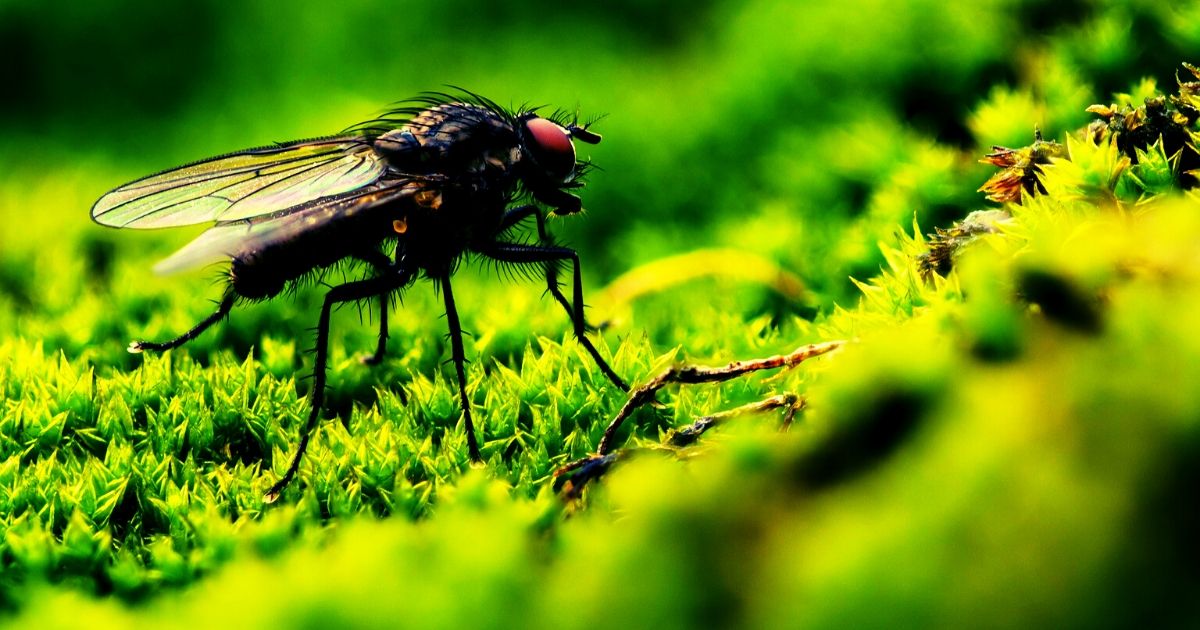The Complete Guide to Flies Prevention, Treatment and Control in Singapore
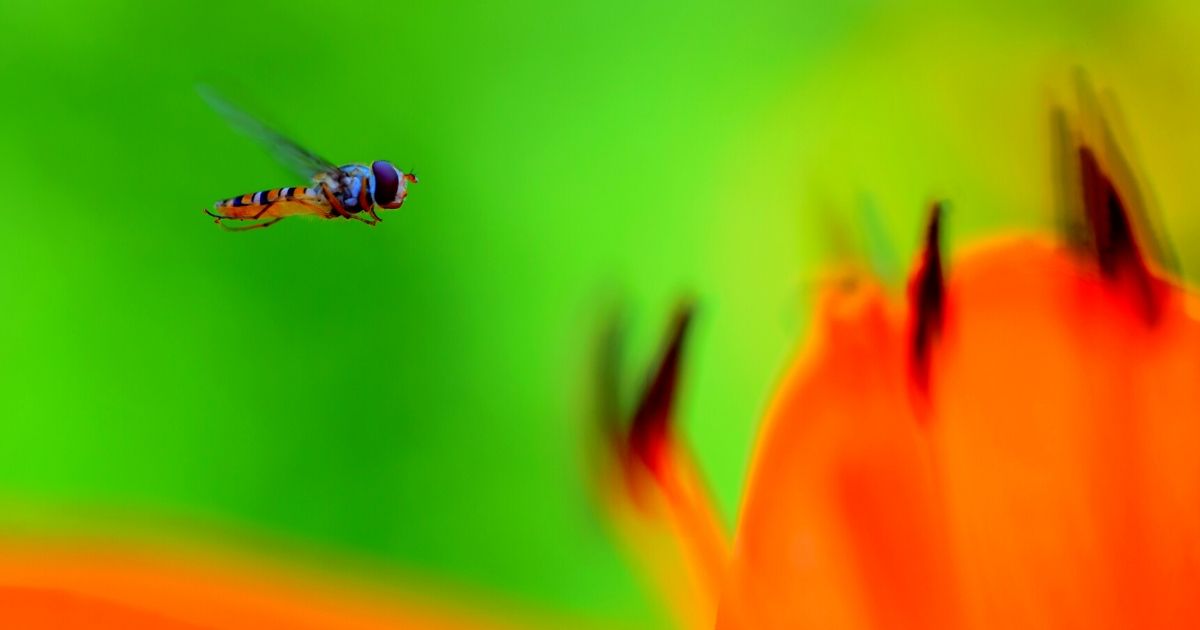
Flies are present around us. Their presence can cause severe problems to some people, such as the owners of food and beverage outlets. Besides food, flies are attracted to other materials such as rubbish, faeces, and decaying materials.
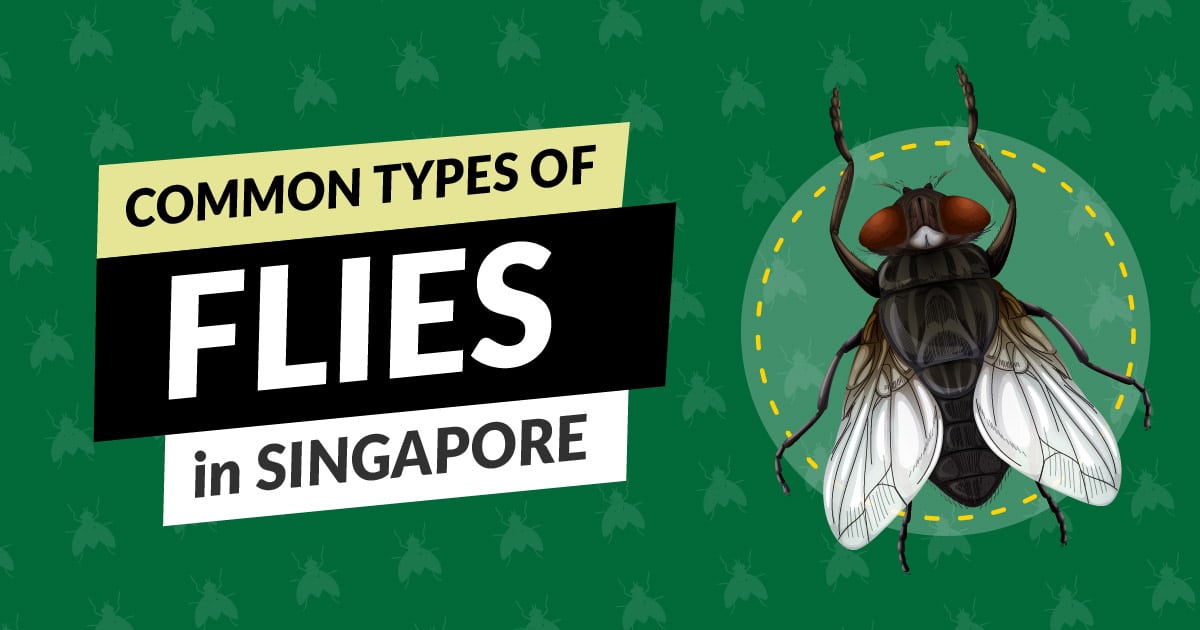
Types of Flies in Singapore
Housefly (Musca domestica)
The houseflies are probably the most notorious species of flies. They can be recognized by the presence of four vertical stripes on their back and their grey colour body. Houseflies are usually found near the waste collection area, such as waste bins and bin centres, as they feed on food waste as well as excretory waste. Their presence at homes is a nuisance to many homeowners.
Fruit fly (Drosophila spp.)
The fruit fly is another species of fly that is found around us. They are around 3mm in size, yellowish-brown, and most of them have red eyes which makes it easy to distinguish them. Fruit flies are attracted to
- Ripened fruits
- Vegetables
- Wine
- Liquor
Bluebottle fly (Calliphoridae)
The bluebottle flies have a distinct metallic-blue body and red eyes, with a body size ranging from 10mm to 14mm. They are often found flying around waste bins searching for food. Bluebottle flies are also attracted to the faeces and decomposing dead bodies of animals.
Flesh fly (Sarcophagidae)
Flesh flies are similar in size to bluebottle flies, but they have a grey body and can be distinguished by the three vertical stripes at the back of the thorax. Flesh flies breed on feces, dead bodies, and even open wounds (which their name implies).
Drain fly (Psychodidae)
The drain flies or sewer flies are also known as moth flies, as they have a fuzzy body that resembles moths. They are usually around 2mm and can be found around the sewage system, such as drains and floor traps which serve as their breeding sites. Drain flies feed on organic matter that is found in the sewers.
Phorid fly (Megaselia)
The phorid flies are another important fly species commonly found in Singapore. Due to their appearance, they are often mistaken to be fruit flies. Phorid flies breed in the drainage system as well as decaying materials, including plants.
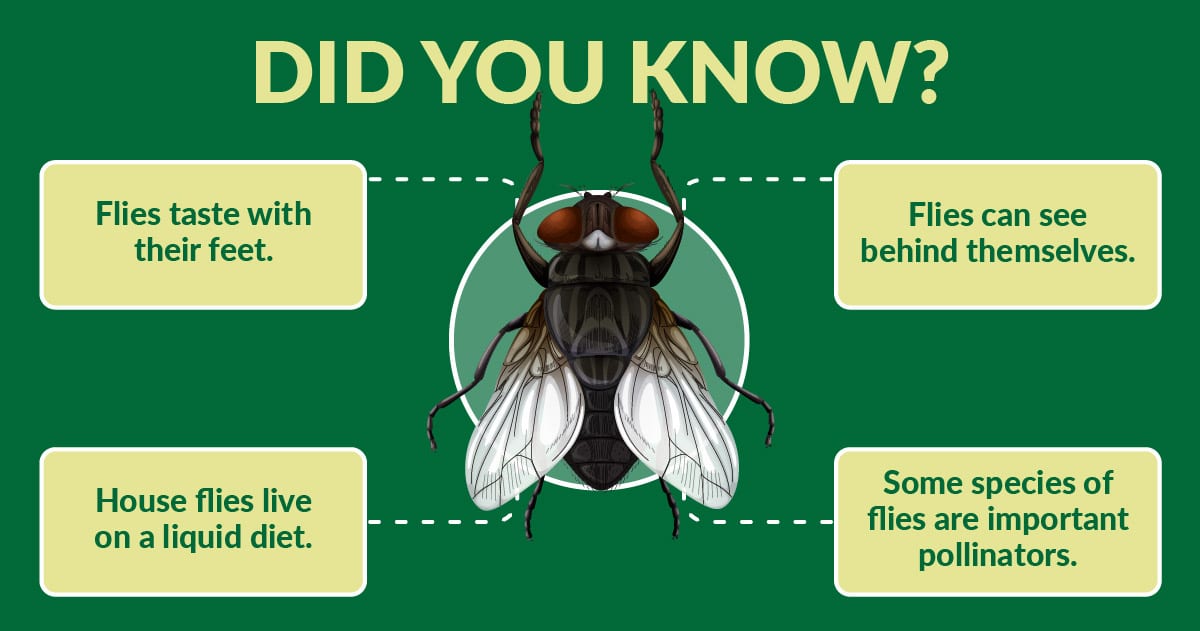
Life Cycle and Biology
Flies undergo complete metamorphosis, and their life stages consist of the egg, larval, pupal, and adult stages. The eggs differ in size and shape depending on the species. Generally speaking, they are laid on or near the larvae’s food sources, such as food waste in the case of house flies. The eggs hatch into larvae that resemble a worm. Some are commonly known as maggots. The larvae feed, store nutrients and gain energy. Then they turn into pupae before emerging as adults.
The life cycle of a house fly only lasts for around 30 days, but in their short lifetime, they manage to lay up to 500 eggs.
Want to find out more about fly pest control in Singapore?
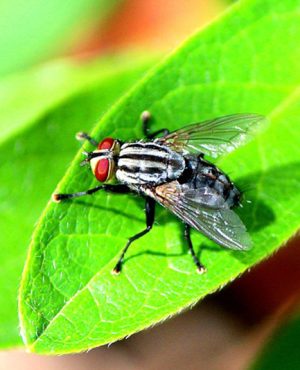
Medical Importance
Flies are associated with poor sanitation and hygiene as well as the ability to transmit diseases. People dislike flies for these reasons.
Flies are mechanical vectors of diseases and conditions such as:
- Dysentery
- Diarrhoea
- Cholera
- Typhoid
- Salmonellosis
Flies pick up pathogens as they crawl and feed on infected surfaces with poor sanitation. They then transmit the pathogens to another object that they rest on, or through direct contact with humans. As flies feed, they regurgitate food, and this process facilitates the transmission of pathogens. The transmission of diseases can be prevented by avoiding unsanitised or contaminated cooking utensils and by making sure that food is not contaminated. It is important to keep flies away from food and utensils through proper storage and good housekeeping practices.
What Attracts Flies?
Flies have an excellent sense of smell. Studies have shown that certain flies can detect odours from up to 7km away. They can also detect odour from stains that are not visible to the naked eyes, making them highly efficient in searching for food. The presence of the following items may be the reason why flies are found around your house or premises:
- Food waste or decaying food
- Food stains
- Ripen fruits
- Sewer or drains
- Faeces or dead bodies of animals
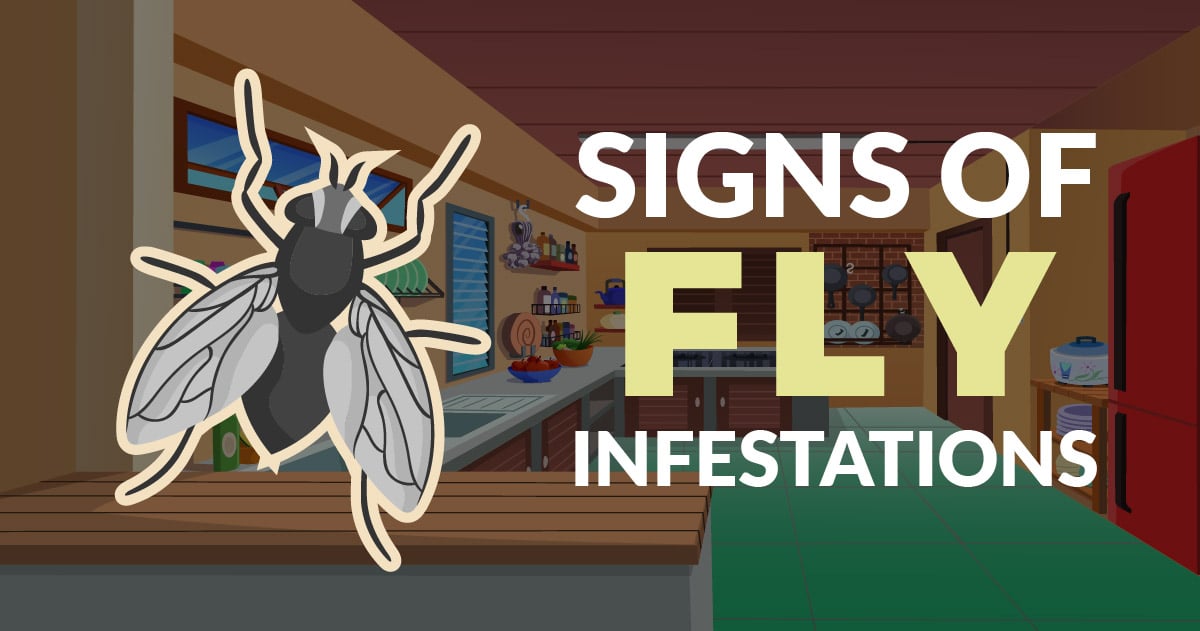
Signs of Fly Infestations
1. Sightings of flies around your house
It may be normal to occasionally spot flies around your house, as they may enter your home from the external while foraging for food. However, if you have seen flies around your house frequently or if you are noticing an increase in the number of flies, you may want to start looking for breeding sites for flies.
2. Presence of maggots around the house
Besides seeing flies flying around, the sighting of maggots usually signals a fly infestation nearby, as they usually will not venture far from their breeding sites. Follow the trails of the maggots or search the nearby areas. You should then be able to locate the breeding sites of flies.
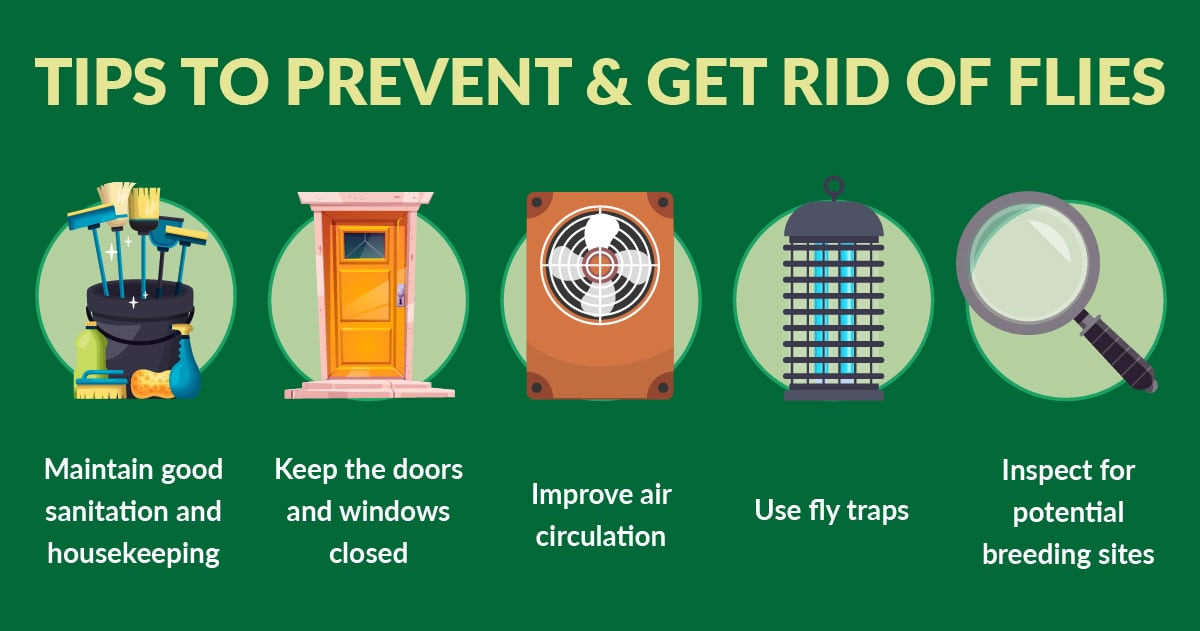
Tips to Prevent Flies From Invading Your Home
1. Maintain good sanitation and housekeeping
One of the most effective ways to keep pests out is by maintaining good housekeeping practices. Bad housekeeping and sanitation provide pests with sources of food, water and shelter, thus attracting them. Here are some important actions to take note of to keep flies away from home.
- Cover food. Flies have excellent olfactory senses, so the smell of food can attract them from afar. Properly covering food will prevent you from sharing food with flies and avoid contamination of food.
- Cover bins and empty them regularly. The kitchen bins and dustbins are where the food waste and leftovers end up. Flies are not as picky as humans, so the bins are great places for them to look for food. Covering the bins with lids will prevent flies from gaining access to food. Regularly emptying the bins will help avoid the accumulation of rotten food that attracts flies.
- Wipe and clean properly. Flies can feed on human food stains and grease. Thus it is important to keep the surfaces of food preparation areas and dining areas clean. Flies can detect stains or chemicals that are not visible to the human eye. Therefore, it is important to clean and wipe the kitchen. Cleaning properly will remove any materials that may attract flies. Do not let the dishes sit in the sink for too long, as the stains can also attract flies. Cutlery and utensils should be cleaned as soon as possible after use to avoid attracting flies.
- Keep drains clear. The accumulation of organic materials in drains form the ideal breeding sites of drain flies and even phorid flies. To prevent the breeding of drain flies, it is essential to make sure the drains are not clogged. Drains can be cleaned using drain cleaners or even hot water to remove the build-up of organic materials.
2. Keep the doors and windows closed
You can keep flies out by keeping the door and windows of the kitchen closed. Installing insect screens is another feasible alternative as it can keep flies out without making your kitchen and your home stuffy. Air curtains use fast-moving air to create a barrier that prohibits flies from passing through.
3. Improve air circulation
The movement of air disrupts the flight of flies, especially the smaller species, as they are weak fliers. Keep air circulating inside the kitchen by switching on the fan. This helps keep flies away.
4. Use fly traps
Flytraps are effective tools that are widely used in the control of flies. However, the use of fly traps with zappers is not recommended in the kitchen or dining area as they tend to break flies into pieces. Those body parts may fall into the food.
5. Inspect for potential breeding sites
Carry out regular inspections around your house or pay extra attention to the surroundings to spot the breeding sites of flies. Fix any cracks or building defects to prevent the breeding of pests, including flies. Early detection of fly activities will prevent the situation from escalating.
DIY Methods to Prevent Flies in Singapore
There are many types of homemade fly traps that are effective against flies. One of the easiest ways to make a fly trap involves using a bottle or jar and a cover or lid, apple cider vinegar, and dishwasher liquid. The trap is prepared by mixing one tablespoon of dishwasher liquid with apple cider vinegar in a bottle or jar. The bottle or jar is then covered correctly. A small hole is made on the cover as an entrance for the flies. This trap is effective against house flies and fruit flies as its scent will attract them.
Professional Flies Treatment
If you ever feel that the infestation is getting out of control, or if you wish to have peace of mind without worrying about flies infesting your properties, seek assistance from pest management professionals. Pest management professionals will design a management programme that is best suited for you to combat flies.
The first step of professional flies treatment involves thorough inspection to obtain information such as the severity of the infestation and identifying the source of the infestation. At Killem Pest, our pest management professionals (PMP) are professionally trained and updated with knowledge of pests. The PMPs will be able to determine suitable management programmes based on their evaluation. They can also identify breeding sources that may not be discoverable to ordinary people based on their experience in the field.

Pest Problem? Let Us Help.
We offer fast and effective precision treatments to eliminate pests while ensuring a safe environment for your home or business.
As mentioned earlier, fly traps are essential tools in fly management. The fly traps used by Pest Management Professionals are the insect light traps that attract flies using ultraviolet (UV) light. The UV light traps used by the professionals emit rays of a specific wavelength which, in turn, attracts flies. The flies are then trapped by the glue boards placed near the light source. The placement and position of the light traps play an important part in determining the effectiveness of the flies control programme. Poorly positioned insect light traps are ineffective and may cause other hazards if not installed correctly. Our PMPs will determine the ideal locations for the deployment of traps based on the inspection carried out.
Another treatment method for flies involves residual spraying. Residual spraying should only be carried out at locations without food to prevent contamination of food with chemicals. Residual spraying can be carried out in areas where flies rest, such as on the walls. Residual spraying should be carried out while paying attention to the surroundings to limit human and pets’ exposure to the chemicals.
Are you having problems with flies in your properties? Contact Killem Pest now.
Frequently Asked Questions
The short answer: all flies are somewhat dangerous. Flies are known for spreading different pathogens and diseases, as they crawl and feed on infected surfaces with poor sanitation.
Prevent fly infestation by maintaining good sanitation at your home. To get rid of flies, you can use fly traps or consult pest management professionals about using chemical pesticides.





